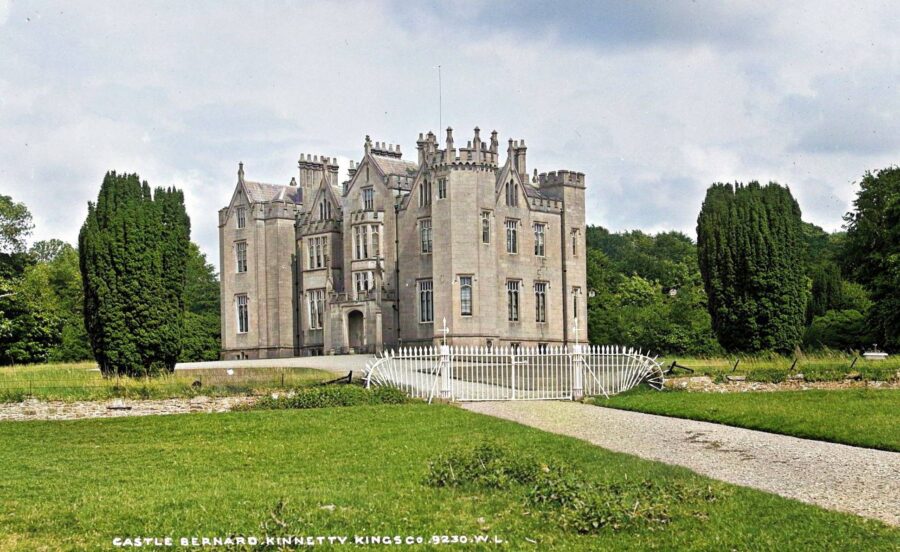Kinnitty Castle (Castle Bernard): A Journey Through Time in County Offaly, Ireland
Kinnitty Castle (Castle Bernard): A Journey Through Time in County Offaly, Ireland
Introduction to Kinnitty Castle
Located in the heart of Ireland, Kinnitty Castle is an enchanting Gothic Revival structure nestled in the stunning Slieve Bloom Mountains of County Offaly. Steeped in history and surrounded by lush, verdant landscapes, Kinnitty Castle has been a symbol of Irish heritage for centuries. In this article, we will explore the rich history of Kinnitty Castle and its significance within County Offaly, Ireland.
Early History of Kinnitty Castle
Kinnitty Castle’s story begins in the early 5th century, during the time of Saint Patrick. Initially, the site was home to a Druidic monastery, which was later replaced by a Christian monastery in the 6th century. The monastery flourished, becoming a prominent hub of education and religion in the region.
The first castle was built on the site around 1209 by the O’Carroll family, rulers of the ancient Kingdom of Ely O’Carroll. The original structure was a Norman-style fortress, constructed to protect the O’Carroll lands and consolidate their power. This early castle was occupied by the O’Carrolls until the 16th century, when it was confiscated by the English Crown during the plantation of Offaly.
The Rebuilding of Kinnitty Castle in the 17th Century
In the 17th century, Kinnitty Castle underwent a transformation. The English Crown granted the castle to Colonel Thomas Winter as a reward for his service during the Cromwellian wars. Winter reconstructed the castle, transforming it into a Georgian mansion with a fortified bawn (an enclosed courtyard). Despite this renovation, the castle was still closely associated with the O’Carroll family, who continued to reside there for several generations.
The 19th Century Gothic Revival
Kinnitty Castle was once again rebuilt in the early 19th century, this time by the Bernard family. Sir Richard Bernard, the then-owner, commissioned architect Richard Morrison to redesign the castle in the popular Gothic Revival style. The result was a breathtaking, grandiose structure featuring pointed arches, pinnacles, and detailed stone carvings. The newly rebuilt Kinnitty Castle was completed in 1811, becoming the stunning architectural gem we see today.

Ownership Changes and Modern Times
Throughout the 19th and 20th centuries, Kinnitty Castle changed hands several times. In the 1920s, the Irish Land Commission acquired the castle and its surrounding lands, dividing the property among local farmers. The castle itself was then used as a forestry training school.
In the 1950s, the castle was purchased by Lord Decies, who spent a significant amount of money restoring the building and its gardens. He then sold Kinnitty Castle to the Ryan family, who opened it as a hotel in the late 1960s.
Today, Kinnitty Castle operates as a luxurious hotel and event venue, offering guests a unique opportunity to experience a piece of Irish history firsthand. The castle’s opulent interiors and beautiful grounds provide an unforgettable setting for weddings, corporate events, and other special occasions.
Haunting Tales of Kinnitty Castle
Like many ancient Irish castles, Kinnitty Castle has its share of ghost stories and supernatural legends. The castle is said to be haunted by several spirits, including a phantom monk known as the ‘Black Abbott’ and a mysterious lady dressed in white. Guests and staff have reported strange occurrences, such as unexplained noises, chilling cold spots, and objects moving by themselves.
These tales only add to the allure of Kinnitty Castle, drawing visitors from far and wide who are eager to explore its fascinating history and perhaps even encounter a ghostly presence.
The Surrounding Area: Exploring County Offaly
Kinnitty Castle’s picturesque location in the heart of County Offaly offers visitors an opportunity to immerse themselves in the region’s natural beauty and rich cultural heritage. The Slieve Bloom Mountains, which form the backdrop of the castle, provide a wealth of outdoor activities, including hiking, cycling, and horseback riding. With breathtaking views, vibrant flora and fauna, and ancient archaeological sites, the Slieve Bloom Mountains are a must-visit for anyone coming to Kinnitty Castle.
County Offaly is also home to several historic landmarks and attractions worth exploring, such as the ancient monastic site of Clonmacnoise, the Tullamore D.E.W. whiskey distillery, and Birr Castle, which houses one of the world’s largest telescopes.
Kinnitty Castle: A Unique Experience in Irish History
Kinnitty Castle is a remarkable testament to Ireland’s rich architectural and cultural history. Its dramatic transformation from a 5th-century monastery to a 19th-century Gothic Revival castle reflects the changing face of Irish society over the centuries. Today, Kinnitty Castle stands as a proud symbol of County Offaly’s heritage, offering visitors a unique and unforgettable experience of Irish history, culture, and natural beauty.
In conclusion, Kinnitty Castle is a true gem in the heart of Ireland. Its long and storied history, coupled with its stunning architecture and picturesque surroundings, make it an essential destination for anyone interested in exploring Ireland’s rich past. Whether you’re drawn to the castle by its haunting legends, its breathtaking location in the Slieve Bloom Mountains, or its significance within County Offaly, you’ll undoubtedly leave Kinnitty Castle with a newfound appreciation for the fascinating story that unfolds within its ancient walls.
Did you find this helpful?
IrishHistory.com is a website that relies on community contributions to help make it better. If you have a suggestion to improve this page, or have spotted any errors, please click ‘Suggest an Edit’
